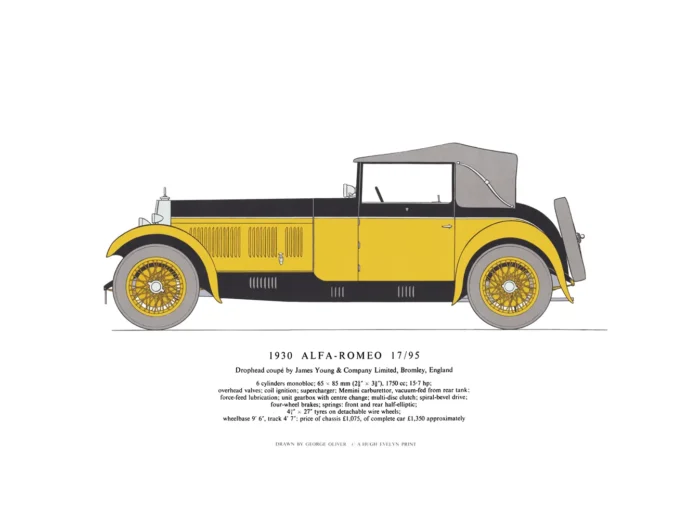1930 Alfa-Romeo 17-95
Original price was: £20.00.£15.00Current price is: £15.00.
Alfa-Romeo 17-95 (scroll down for a more detailed Description)
Published 1961 by © Hugh Evelyn Limited; drawn by George A. Oliver (1920-1990)
Size: c. 47.5 x 34.5 cm [18 ½″ x 13 ½″] – may vary slightly from printers’ cut 50 years ago
Printed on medium white cardstock weighing c. 136 g/sm2
Print is LARGE size – shipping is the same for 1 to 10 prints (based on largest print size in your order) – see Shipping & Returns.
In stock
Description
After the First World War, Alfa was building good, reliable production cars but lacked the expertise to design successful racing machinery, so a scheme was hatched to hire the engineer responsible for Fiat’s Grand Prix racing cars, Vittorio Jano. With the 6C 1500 as base, engineer Jano set out to design a new car for 1929, launched at the Rome Motor Show. It was dubbed 6C 1750 (107 Ci3) after its 1752 cc ‘six’ engine. Adept on both road and racing circuits, the powerplant proved reliable and powerful, offering impressive output from its relatively small displacement. Further benefiting from excellent handling, the car, in top factory racing engine trim, could comfortably exceed 161 km/h (100mph). The 6C 1750 is significant for introducing in-house manufactured saloon bodies along with those produced by firms such as Touring, Castagna, Zagato and James Young (as here). Three models were available: the single overhead cam Turismo with 122-inch wheelbase and a maximum speed of about 110 km/h, the twin overhead cam Gran Turismo with 108-inch or 114-inch wheelbase and a top speed of about 130 km/h, and the Gran Sport, a supercharged Gran Turismo producing 85 hp and a top speed of 150 km/h. The Alfa Romeo 6C 1750 was produced in six series and evolved step by step from 1929 to 1933. A total of 2,579 1750s were built, of which only about 360 were supercharged “GS” examples. Many had unique specification to cope with a variety of motor sport events.
Additional information
| Weight | 0.0227 kg |
|---|---|
| Dimensions | 48 × 48 × 35 cm |





